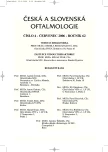Slovenská štúdia efektivity liečby travoprostom
The Slovak Study of the Travoprost Treatment Efficacy
Purpose:
To confirm the efficacy of the travoprost treatment during twelve months follow-up in groups of patients: without previous treatment, with different previous anti-glaucomatous treatment, and with different stage of compensation.
Patients and methods:
The study evaluates the lowering of the intraocular pressure (IOP) in 143 patients (286 eyes). The intraocular pressure was measured by means of aplanation tonometry, before the treatment started, and after 1, 3, 9, and 12 months at 8–9 o’clock a.m. Patients were divided into eight groups according to the previous mono therapy or combined therapy substituted by travoprost mono therapy or its combination. A special group constituted patients with travoprost as a primary treatment.
Results:
In the first group, with latanoprost substituted by travoprost, the intraocular pressure decreased by 7 % (p ≤ 0.0001). In the second group of patients, with travoprost as the primary glaucoma treatment, the intraocular pressure decreased by 22 % (p ≤ 0.0001). In the third group, the beta-blocker was substituted by travoprost, with 22 % (p ≤ 0.0001) decrease of the IOP. In the fourth group, the combined therapy of beta-blocker with latanoprost was substituted by combination of beta-blocker and travoprost and the decrease by 8 % (p ≤ 0.0001) was significant during the first nine months of the follow-up period, later on, the decrease was not significant. The substitution of the combination of beta-blocker and latanoprost by travoprost mono therapy in the fifth group created only no significant lowering of the IOP during the whole follow-up period. If the travoprost mono therapy substituted the combination of beta-blocker with local carboanhydrase inhibitor in the sixth group, the IOP decreased by 20 % (p ≤ 0.001). In the seventh group, the combination of the local carboanhydrase inhibitor and latanoprost was substituted by combination of the local carboanhydrase inhibitor with travoprost, the IOP lowering was not significant. On the other hand, in the eighth group, different combinations of antiglaucomatics were substituted by travoprost, and this caused significant lowering of IOP by 20 % (p ≤ 0.0001). In all cases, the lowest decrease of IOP during the whole follow-up period in the eye with worse compensation is given.
Conclusion:
Travoprost lowered effectively the intraocular pressure in 6 out of 8 groups of patients, e.g. in 129 patients (out of 143 patients), the range of lowering was 7–28 % bellow the initial level, the follow up period was 12 months. The decrease of the IOP was stable. The drug was well tolerated.
Key words:
glaucoma, travoprost, prostaglandines, combinations of antiglaucomatic drugs
Autoři:
M. Potocký
Působiště autorů:
Súkromná očná klinika Veni-Vidi, s. r. o., Obchodná 44-46, Bratislava
vedúci pracoviska doc. MUDr. Marián Potocký, Ph. D.
Vyšlo v časopise:
Čes. a slov. Oftal., 62, 2006, No. 4, p. 263-269
Souhrn
Cieľ štúdie:
overiť efektivitu liečby travoprostom počas 12-mesačného pozorovania v skupinách pacientov bez predchádzajúcej liečby, s rozličnou predchádzajúcou antiglaukomatóznou liečbou a rozličným stupňom kompenzácie.
Pacienti a metódy:
štúdia hodnotí zníženie vnútroočného tlaku (VOT) u 143 pacientov t.j. 286 očí. Vnútroočný tlak sa meral aplanačne pred začatím liečby po 1, 3, 9 a 12 mesiacoch v dobe medzi 8. a 9. hodinou. Pacienti boli rozdelení do 8 skupín, podľa predchádzajúcej liečby mono alebo kombinovanou terapiou, ktorá bola nahradená monoterapiou travoprostom alebo jeho kombináciou. Zvláštnu skupinu tvorili pacienti, kde travoprost bol primárnou liečbou.
Výsledky:
v 1.skupine, kde predchádzajúca liečba latanoprostom bola nahradená travoprostom, poklesol vnútroočný tlak o 7 % (p £ 0,0001). U 2. skupiny pacientov, kde travoprost bol primárnou liečbou glaukómového ochorenia, poklesol vnútroočný tlak o 22 % (p ≤ 0,0001). V 3. skupine sme nahradili betablokátor travoprostom, čo prinieslo 22 % (p ≤ 0,0001) pokles VOT. Vo 4. skupine sme kombináciu betablokátora s latanoprostom nahradili kombináciou betablokátora s travoprostom a docielili sme signifikantný pokles o 8 % (p ≤ 0,0001) počas 9 mesiacov, potom pokles nebol signifikantný. Nahradenie kombinácie betablokátora s latanoprostom monoterapiou travoprostom v skupine 5 prinieslo len nesignifikantné zníženie VOT počas celej sledovacej doby. Ak monoterapia travoprostom nahradila kombináciu betablokátora s lokálnym inhibítorom karboanhydrázy v 6. skupine, VOT poklesol o 20 % (p ≤ 0,001). V skupine 7, kde kombinácia topikálneho inhibítora karboanhydrázy s latanoprostom bola nahradená kombináciou topikálneho inhibítora s travoprostom, bol pokles VOT nesignifikantný. Naopak, v skupine 8, kde sa rozličné kombinácie antiglaukomatík nahradili travoprostom, tento spôsobil signifikantný pokles VOT o 20 % (p ≤ 0,0001). Uvádza sa vždy najnižší pokles VOT počas celej sledovanej doby na oku s horšou kompenzáciou.
Závery:
travoprost znižoval efektívne vnútroočný tlak v 6 z 8 skupín, t.j. u 129 pacientov v rozmedzí 7–28 % z hodnoty pred liečbou počas 12 mesiacov sledovania. Pokles VOT počas celej sledovanej doby bol stabilný. Tolerancia lieku bola dobrá.
Kľúčové slová:
glaukóm, travoprost, prostaglandíny, kombinácie antiglaukomatík
Štítky
OftalmologieČlánek vyšel v časopise
Česká a slovenská oftalmologie

2006 Číslo 4
- Stillova choroba: vzácné a závažné systémové onemocnění
- Kontaktní dermatitida očních víček
- Diagnostický algoritmus při podezření na syndrom periodické horečky
- Citikolin jako užitečný pomocník v léčbě diabetické retinopatie a glaukomu
- Léčba chronické blefaritidy vyžaduje dlouhodobou péči
Nejčtenější v tomto čísle
- TINU syndrom
- Antiglaukomatika – obsah konzervačních látek a spolupráce pacienta v léčebném režimu
- Chirugické řešení submakulární hemoragie v kombinaci s tkáňovým aktivátorem plazminogenu (kazuistické sdělení)
- Infliximab v léčbě Wegenerovy granulomatózy: kazuistika
